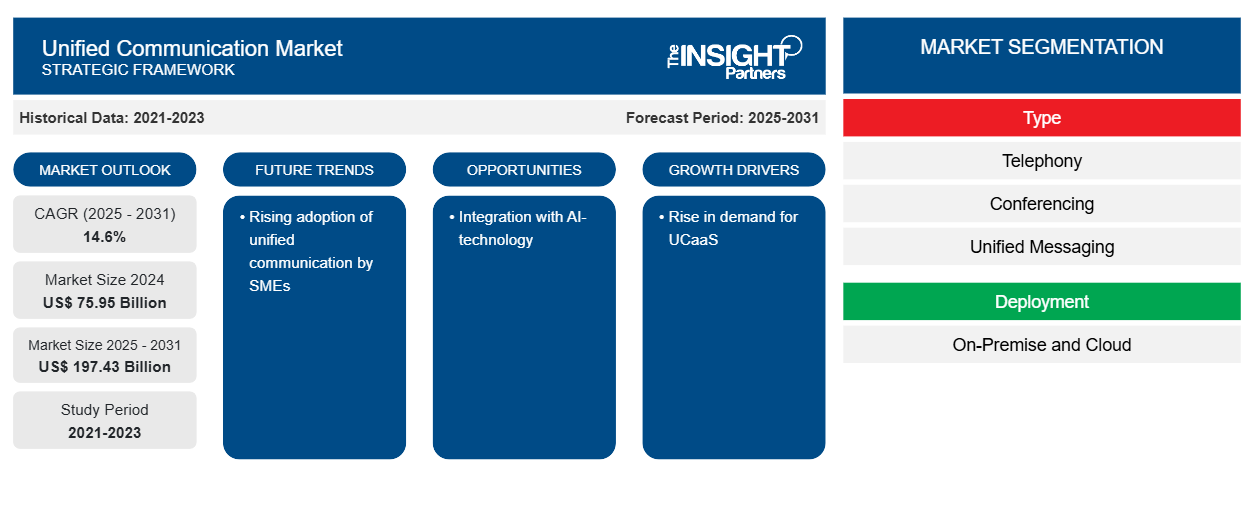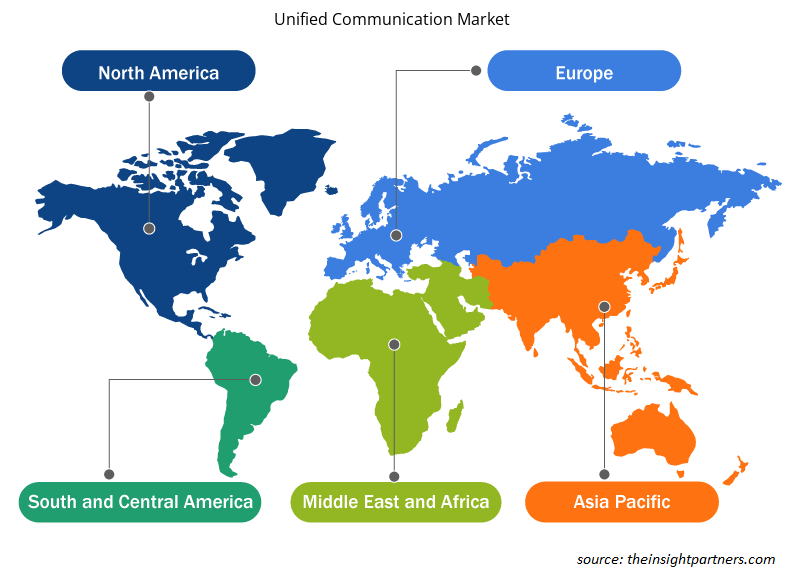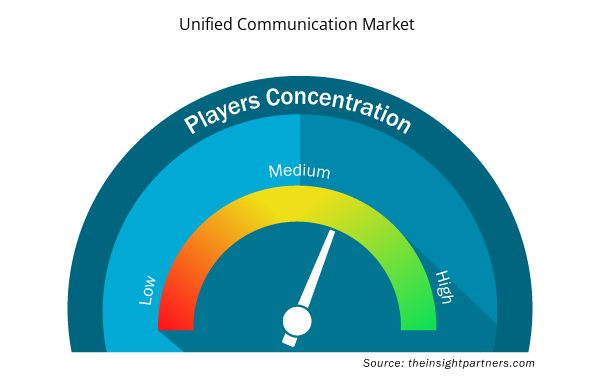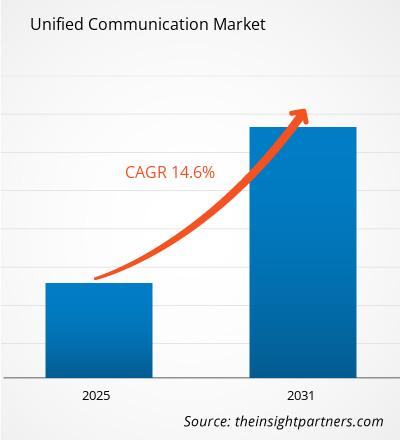The unified communication market size is projected to reach US$ 197.43 billion by 2031 from US$ 66.27 billion in 2023. The market is expected to register a CAGR of 14.6% in 2023–2031. The growing demand for UCaaS and the increasing demand for cloud-based solutions are likely to remain key to unified communication market trends.
Unified Communication Market Analysis
The unified communications market has witnessed significant growth over the past few years, primarily fuelled by the rising demand for remote collaboration among distributed workforce across different verticals. The objective of this is to unify and simplify business communication, boost the team's efficiency and collaboration, and provide a better customer experience. It offers several benefits, such as improved productivity, support for effective communication between a mobile and remote workforce, and lower capital investments required for administration and maintenance, among other benefits. Its Inherent nature is to integrate a wide range of applications onto a common, singular platform. While it makes for a powerful solution, the effectiveness of the same is dependent on the vendor's ability to provide unified networking among the elements. Some vendors natively offer most of these elements, while others depend on external partners for pre-integrated solutions to provide a seamless experience. With new applications being developed on a regular basis, interoperability becomes an ongoing challenge. While the presence of several unified communication vendors allows for a highly competitive nature of the market, better harmony is required among such vendors to meet the needs of their customers efficiently. Since all forms of interoperability are not equal, end users evaluate their vendors critically to ensure that their solutions can integrate seamlessly into the user's existing network environment.
Unified Communication Market Overview
Unified communications describe the different forms of interaction and collaboration between communication tools. By unifying web conferencing, SMS, phone calls, and email, among others, team members can share and access data and work together in real-time over an internet connection. Irrespective of the size of the business, the right solution can take business processes to the next level. It improves collaboration, boosts productivity, increases mobility and enhances the user experience. A unified communications environment is usually supported by one or multiple back-end management systems, or unified communication platforms, that ease the integration among services and also the front-end clients, providing access. This has transformed in the past few years from mostly supporting on-site collaboration through in-room conferencing to allowing collaboration among remote workforces with audio and video conferencing and others.
Customize This Report To Suit Your Requirement
You will get customization on any report - free of charge - including parts of this report, or country-level analysis, Excel Data pack, as well as avail great offers and discounts for start-ups & universities
Unified Communication Market: Strategic Insights

- Get Top Key Market Trends of this report.This FREE sample will include data analysis, ranging from market trends to estimates and forecasts.
Customize This Report To Suit Your Requirement
You will get customization on any report - free of charge - including parts of this report, or country-level analysis, Excel Data pack, as well as avail great offers and discounts for start-ups & universities
Unified Communication Market: Strategic Insights

- Get Top Key Market Trends of this report.This FREE sample will include data analysis, ranging from market trends to estimates and forecasts.
Unified Communication Market Drivers and Opportunities
Rise in demand for UCaaS
Presently, unified communications support hybrid in-office and at-home workforces, which is a trend strongly adopted during the COVID-19 pandemic. To support such distributed workforces, enterprises are shifting to unified communications as a service (UCaaS)_ It is part of the broader migration to the cloud that all businesses are managing. UCaaS allows for remote collaboration, which is a big requirement for such a distributed workforce. Instead of using communication apps, often supported by different vendors, on a standalone basis, UCaaS combines all these services and also integrates applications such as messaging, email, video conferencing, and VolP. It is also beneficial for the in-house information technology (IT) team since one vendor is responsible for the entire deployment. Further, most remotely working employees generally work in multiple settings and utilize different devices with different endpoints. In addition, employees are prone to routinely shifting modes for their day or a particular session. They may be shifting from desktop to smartphone, instant messaging to voice over internet protocol (VolP) or from one-to-one email to video conferencing for a team meeting. It can provide a consistent user experience over such various devices.
Additionally, UCaaS is subscription-based and hence is an operational expenditure (OPEX), as opposed to capital expenditure (CAPEX) incurred for managing disparate systems in-house. Numerous macroeconomic factors across the globe created a severely adverse environment for businesses. The pandemic caused severe disturbances, which led to huge losses for various industry verticals. Political turmoil in Europe, the Middle East, and South America has been negatively affecting different industry verticals in different ways. Severe economic downturns in several countries have resulted in decreased consumer spending on discretionary goods. Thus, most industry verticals have endured losses due to such a decrease in consumption. Such factors have compelled enterprises to adopt different measures to remain competitive through a reduction in capital expenditure. Thus, being an OPEX, UCaaS is registering strong demand from both SMEs and large enterprises. Such advantages and trends are strongly boosting the demand for a unified communications market globally.
Rising adoption of unified communication by SMEs
Worldwide, constant practices are implemented to support SMEs. Several initiatives, schemes, and financial aid are provided for SMEs to encourage them to stand firm in the global market. For example, The World Bank Group offers tools that small- and medium-sized enterprises (SMEs) can use to improve their access to finance and markets, as well as unlock new sources of capital such as SME Lines of Credit, Partial Credit Guarantee Schemes, Early-Stage Innovation Finance, IDA Private Sector Window, and others. Such support boosts the SME's capability to adopt cost-effective digital solutions to run their business more efficiently and digitally. This factor leads to the adoption of a unified communication solution. A unified communications solution is a cost-effective tool that any small business can adopt. In addition, cloud-driven solutions enable SMEs to cut costs and even boost productivity.
Unified Communication Market Report Segmentation Analysis
Key segments that contributed to the derivation of the unified communication market analysis are type, deployment, organization size, and vertical.
- By type, the market is segmented into telephony, conferencing, unified messaging, and others. The unified messaging segment held the largest market share in 2023.
- Based on the deployment, the market is segmented into on-premise and cloud. The cloud segment is expected to grow with the highest CAGR.
- Based on the organization size, the market is segmented into SMEs and large enterprises. The SMEs segment is expected to grow with the highest CAGR.
- By vertical, the market is segmented into academic & public institutions, BFSI, healthcare, IT & telecom, manufacturing, retail & e-commerce, and others. The IT & telecom segment held the largest market share in 2023.
Unified Communication Market Share Analysis by Geography
The geographic scope of the unified communication market report is mainly divided into five regions: North America, Asia Pacific, Europe, Middle East & Africa, and South America/South & Central America.
North America holds a substantial share of the unified communications market The region has a high penetration of 5G networks and has a higher acceptance of advanced technology. Additionally, the region is a pioneer in the development and deployment of such technologies. Additionally, the US and Canada have been witnessing a significant rise in digital transformation amongst enterprises across various verticals. E-commerce is one such vertical that has witnessed a significant surge in the past few years.
Unified Communication Market Regional Insights
Unified Communication Market Regional Insights
The regional trends and factors influencing the Unified Communication Market throughout the forecast period have been thoroughly explained by the analysts at Insight Partners. This section also discusses Unified Communication Market segments and geography across North America, Europe, Asia Pacific, Middle East and Africa, and South and Central America.

- Get the Regional Specific Data for Unified Communication Market
Unified Communication Market Report Scope
| Report Attribute | Details |
|---|---|
| Market size in 2024 | US$ 75.95 Billion |
| Market Size by 2031 | US$ 197.43 Billion |
| Global CAGR (2025 - 2031) | 14.6% |
| Historical Data | 2021-2023 |
| Forecast period | 2025-2031 |
| Segments Covered |
By Type
|
| Regions and Countries Covered | North America
|
| Market leaders and key company profiles |
Unified Communication Market Players Density: Understanding Its Impact on Business Dynamics
The Unified Communication Market market is growing rapidly, driven by increasing end-user demand due to factors such as evolving consumer preferences, technological advancements, and greater awareness of the product's benefits. As demand rises, businesses are expanding their offerings, innovating to meet consumer needs, and capitalizing on emerging trends, which further fuels market growth.
Market players density refers to the distribution of firms or companies operating within a particular market or industry. It indicates how many competitors (market players) are present in a given market space relative to its size or total market value.
Major Companies operating in the Unified Communication Market are:
- Avaya Inc.
- AT and T Inc.
- Cisco Systems, Inc.
- Hewlett Packard Enterprise Development LP
- IBM Corporation
- Microsoft Corporation
Disclaimer: The companies listed above are not ranked in any particular order.

- Get the Unified Communication Market top key players overview
Unified Communication Market News and Recent Developments
The Unified Communication Marketis evaluated by gathering qualitative and quantitative data post primary and secondary research, which includes important corporate publications, association data, and databases. The following is a list of developments in the market:
- In April 2023, Italy today became the latest market to launch Vodafone Business Unified Communications (UC) with RingCentral – a cloud-based solution allowing customers to combine messaging, video meetings, file sharing and virtual phone systems via a single user interface accessible on any internet-enabled device. Vodafone began rolling out its unified communications solution in 2022 in partnership with RingCentral, initially in the UK and Germany, with further markets planned to follow the latest roll-out in Italy. (Source: Vodafone, Press Release, 2023)
- In January 2021, Atos SE (CAC40: ATO) and RingCentral, Inc. (NYSE: RNG), a leading provider of global enterprise cloud communications, collaboration, video meetings, and contact center solutions, announced the first release of Unify Office (UO) in the US. A Unified Communications-as-a-Service (UCaaS), UO enables businesses to communicate and collaborate with ease using industry-leading voice, video, and team messaging capabilities from anywhere and on any device via a single enterprise solution. (Source: RingCentral, Inc, Press Release, 2021)
Unified Communication Market Report Coverage and Deliverables
The “Unified Communication Market Size and Forecast (2021–2031)” report provides a detailed analysis of the market covering below areas:
- Market size and forecast at global, regional, and country levels for all the key market segments covered under the scope
- Market dynamics such as drivers, restraints, and key opportunities
- Key future trends
- Detailed PEST/Porter’s Five Forces and SWOT analysis
- Global and regional market analysis covering key market trends, major players, regulations, and recent market developments
- Industry landscape and competition analysis covering market concentration, heat map analysis, prominent players, and recent developments
- Detailed company profiles
- Historical Analysis (2 Years), Base Year, Forecast (7 Years) with CAGR
- PEST and SWOT Analysis
- Market Size Value / Volume - Global, Regional, Country
- Industry and Competitive Landscape
- Excel Dataset



Report Coverage
Revenue forecast, Company Analysis, Industry landscape, Growth factors, and Trends

Segment Covered
This text is related
to segments covered.

Regional Scope
North America, Europe, Asia Pacific, Middle East & Africa, South & Central America

Country Scope
This text is related
to country scope.
Frequently Asked Questions
The incremental growth expected to be recorded for the global unified communication market during the forecast period is US$ 131.16 billion.
The global unified communication market is expected to reach US$ 197.43 billion by 2031.
The key players holding majority shares in the global unified communication market are Avaya Inc.; AT&T Inc.; Cisco Systems, Inc.; Hewlett Packard Enterprise Development LP; and IBM Corporation.
Integration with AI-technology is anticipated to play a significant role in the global unified communication market in the coming years.
The growing demand for UCaaS and the increasing demand for cloud-based solutions are the major factors that propel the global unified communication market.
The global unified communication market was estimated to be US$ 66.27 billion in 2023 and is expected to grow at a CAGR of 14.6% during the forecast period 2023 - 2031.

 Get Free Sample For
Get Free Sample For